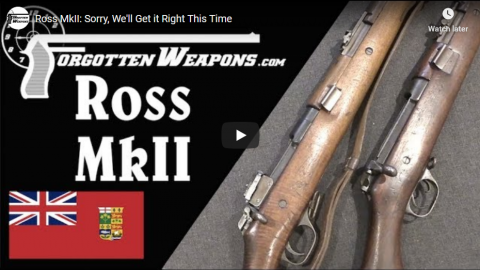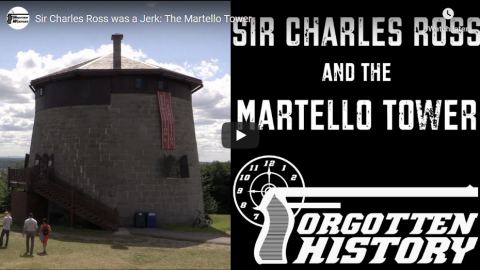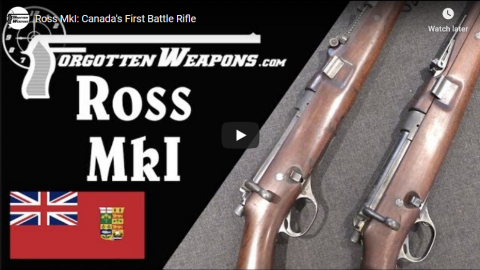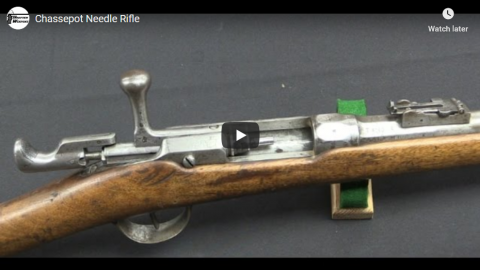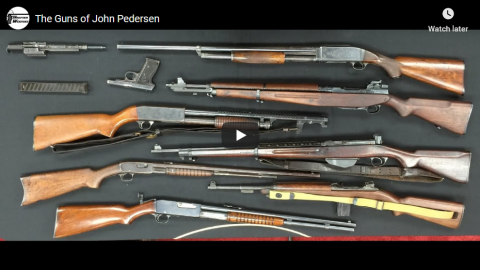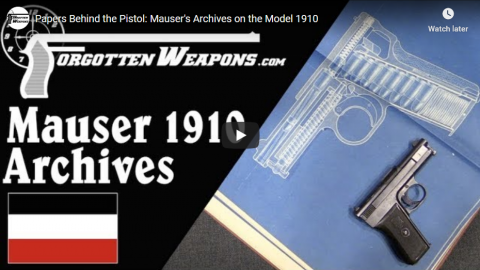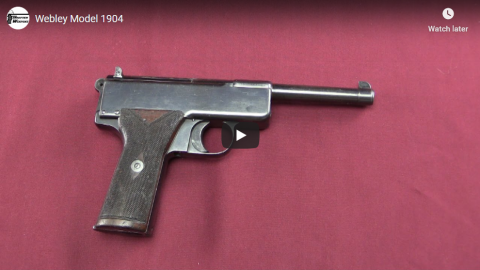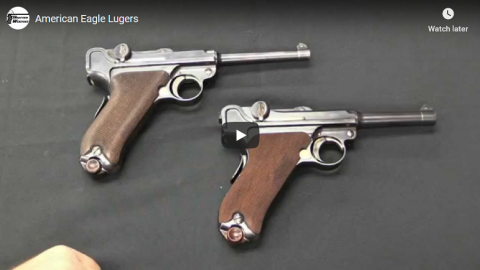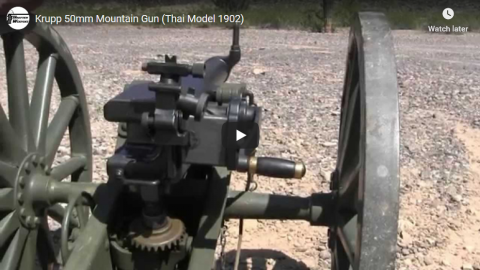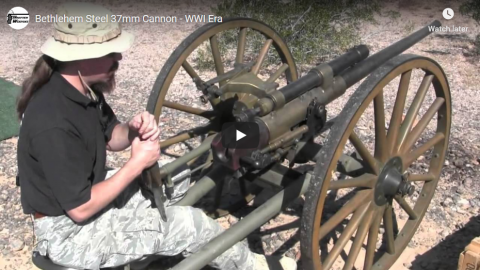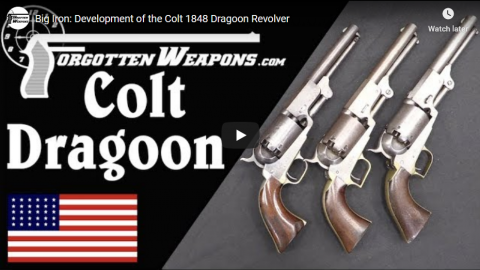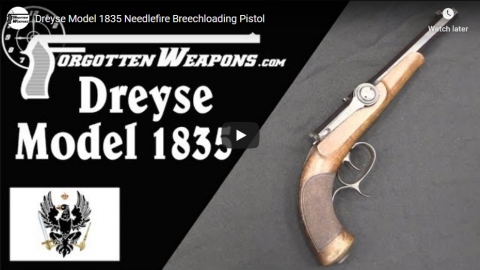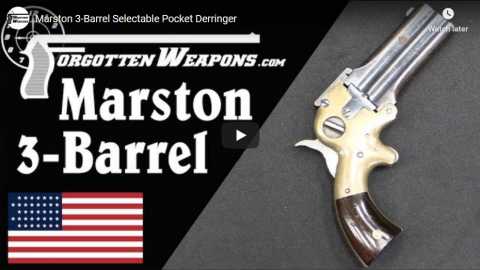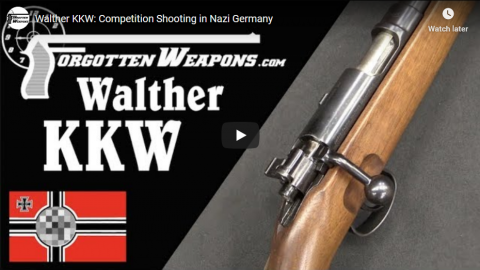Forgotten Weapons
Published 30 Oct 2019http://www.patreon.com/ForgottenWeapons
Cool Forgotten Weapons merch! http://shop.bbtv.com/collections/forg…
The many significant problems with the Model 1903 / MkI Ross rifle had quickly led to the development of the improved MkII design. This strengthened many parts, including the sights, nosecap, bolt latch, and more. The receiver was made thicker, and an extra set of cams added to make the bolt throw smoother. Primary extraction was added by way of angling the locking lugs. Mk II rifles began to come off the Ross Rifle Company production line in December of 1905.
Between its introduction and its replacement by the MkIII in 1912, the MkII Ross would undergo 5 changes in type, mostly involving different rear sights. However, a distinct “long” pattern was also made, designated the MkII**. This model had a longer barrel and some mechanical changes, and was also fitted with a rear aperture sight and stripper clip guide. These would be very successful in competition shooting at the time, and helped salvage the reputation of the Ross after the problems of the MkI.
Overall, 13,700 “long” MkII Rosses were made along with 124,000 of the “short” type. They did see use in World War One, as armament for Canadian artillery units. They were also used as training rifles by the military, and the US government also purchased 20,000 of the MkII3* pattern for use training the multitudes of new US soldiers joining up to fight in Europe.
Many thanks to the private collectors who allowed me access to their rifles to make this video!
Contact:
Forgotten Weapons
6281 N. Oracle #36270
Tucson, AZ 85704
November 3, 2019
Ross MkII: Sorry, We’ll Get it Right This Time
November 2, 2019
Sir Charles Ross was a Jerk: The Martello Tower
Forgotten Weapons
Published 29 Oct 2019Note: These towers were built by the British, not the French. Sorry!
http://www.patreon.com/ForgottenWeapons
Cool Forgotten Weapons merch! http://shop.bbtv.com/collections/forg…
Sir Charles Ross was really a jerk sometimes. Not the sort of guy you would want to go into business with.
Contact:
Forgotten Weapons
6281 N. Oracle #36270
Tucson, AZ 85704
Here are the Wikipedia pages on Sir Charles Ross, Bart. and Martello towers.
November 1, 2019
Ross MkI: Canada’s First Battle Rifle
Forgotten Weapons
Published 28 Oct 2019http://www.patreon.com/ForgottenWeapons
Cool Forgotten Weapons merch! http://shop.bbtv.com/collections/forg…
Sir Charles Ross was heir to a very wealthy Scottish family, and was a talented if temperamental engineer. He took an interest in firearms and their design, and worked with American and English connections to produce a line of his own straight-pull sporting rifles. Upon returning from the Boer War he looked to expand into the military market.
At this same time, the Canadian government was looking to replenish its arms supplies after the war, and requested Enfield rifles form the British. The request was turned down, as Britain did not have enough supply to spare any for the Canadians. The Canadians were expected to construct their own factory to make rifles of he standard British pattern. Well, the Canadian government was not eager to invest that sort of capital into the project. They investigated buying arms elsewhere, but the consensus was that Canada’s armaments should come from either Britain or from within Canada itself. No good solution was apparent until Sir Charles Ross stepped in.
Ross offered to fund the construction of a factory himself, and use Canadian labor and industry to manufacture Ross rifles for the military. This seemed like an excellent solution — for zero initial cash outlay, the Canadian government would get rifles both designed and produced domestically! The rifles would be chambered for the standard .303 British cartridge, thus handling the British objections about arms compatibility (Ross pointed out that the British themselves used something like 7 different patterns of rifle at the time).
In 1902, Ross and the Canadian government signed a contract for 12,000 rifles to be made in 1903 and 10,000 per year thereafter, at the price of $25 each. In addition to the Canadian military, the Royal North West Mounted Police also adopted the new Ross rifle. Deliveries did not actually begin until 1905, and when they did plenty of disturbing problems arose. The rifles proved fragile and unreliable — and a weak bolt latch periodically allowed the bolt to fall completely out of the rifle on parade drill — not a good start!
Only 10,000 of the Mark I Ross rifles were made, and an improved Mark II pattern would follow as quickly as Ross could make it a reality.
Many thanks to the private collectors who allowed me access to their rifles to make this video!
Contact:
Forgotten Weapons
6281 N. Oracle #36270
Tucson, AZ 85704
October 29, 2019
1918 Mauser Tank Gewehr
Forgotten Weapons
Published on 23 Aug 2015http://www.patreon.com/ForgottenWeapons
Cool Forgotten Weapons Merch! http://shop.bbtv.com/collections/forg…
Hammer price: $4,750
Germany was the first country to produce a purpose-built antitank rifle, in response to the major Entente tank attack at Cambrai. The design was pretty simple, basically a scaled-up Mauser 98 with 4 locking lugs chambered for the massive 13.2mm TuF cartridge. It would perforate about 20mm of armor plate at 100m, which was nicely effective on WWI tanks. By the end of the war more than 15,000 had been made. Interestingly, a bunch of them ended up at Springfield Armory, where they were used in the development of the .50 BMG cartridge.
October 26, 2019
Chassepot Needle Rifle
Forgotten Weapons
Published on 30 May 2015Sold for $1,150 (with three other rifles).
The Chassepot was the French answer to the Dreyse needle rifle, and also the only other needlefire rifle to see major military service. It was adopted in 1866 and served as a primary French infantry rifle until being replaced by the 1874 Gras rifle, which was basically a conversion of the Chassepot to use self-contained brass cartridges. The concept of a needle rifle is that of a breech loading rifle using paper cartridges. A primer was set in the base of the cartridge (inside the paper), and upon firing the needle-like firing pin would pierce the paper cartridge and detonate the primer and powder charge. The system always had trouble with sealing the breech, but was still a significant improvement over muzzleloading rifles.
October 23, 2019
The Guns of John Pedersen
Forgotten Weapons
Published on 10 Apr 2015Sold for:
$34,500 (Pedersen Device)
Failed to sell (Model 10 shotgun)
(Model 12 in a later auction)
$1,610 (Model 14 carbine, with one other rifle)
(Military Ithaca 37 in a later auction)
$2,588 (Remington 51 pistol with one other pistol)
(Irwin-Pedersen M1 Carbine in a later auction)
$16,100 (Vickers-Pedersen rifle)
$74,750 (Pedersen GY rifle)John Pedersen was one of the more prolific and successful gun designers in American history, having even been described by John Moses Browning as “the greatest gun designer in the world”. And yet, many people only know about Pedersen from his unsuccessful toggle-locked rifle or his WWI Pedersen Device that never saw action. In truth, Pedersen’s work included a number of very successful sporting rifles and shotguns that many shooters would still recognize today. While looking through the guns at Rock Island on my most recent trip there, I realized that they had examples of virtually every one of Pedersen’s guns — so I figured I should do an overview of the man’s work.
October 22, 2019
Papers Behind the Pistol: Mauser’s Archives on the Model 1910
Forgotten Weapons
Published 21 Oct 2019http://www.patreon.com/ForgottenWeapons
Cool Forgotten Weapons merch! http://shop.bbtv.com/collections/forg…
Courtesy of the Paul Mauser Archive, we have a very cool opportunity to look at the documentation and paperwork behind a production pistol design, from beginning to commercial sales. This sort of documentation is rare for pre-WW1 German small arms in general, and the Mauser Model 1910 pistol is a very rare example of a complete set of archival papers surviving. So, what we can look at is the whole development process from behind the scenes at Mauser. Initial design drawings, blueprints, glass-plate photography, internal assembly instructions, costing, corporate-level final approval, marketing, and final print manuals. Thanks to Mauro Baudino for supplying these original documents for me to show you!
The Paul Mauser Archive (http://www.paul-mauser-archive.com/in…) is a wealth of information for researchers, and make sure to check out the recent book on Mauser coauthored by Mauro Baudino and Gerben van Vlimmeren:
Contact:
Forgotten Weapons
6281 N. Oracle #36270
Tucson, AZ 85704
October 20, 2019
Webley Model 1904
Forgotten Weapons
Published on 24 Feb 2015Sold for $109,250.
The Model 1904 was basically the first working automatic pistol made by Webley (there was a 1903 toolroom experiment, but it didn’t really work). Like all the Webley automatic that would follow, it was designed by William Whiting. The 1904 was the company’s first effort at making a semiautomatic sidearm for the British military, so it was chambered for the .455 cartridge (a special rimless version made by Kynoch, after early experiments using the .455 rimmed revolver ammunition caused lots of problems stacking in magazines). It is a rather huge handgun, and uses a short recoil mechanism with two separate locking blocks. This particular one is s/n 23 – very few were made before it was rejected in military trials and Webley redirected its efforts toward smaller commercial pistols.
http://www.forgottenweapons.com
Theme music by Dylan Benson – http://dbproductioncompany.webs.com
October 17, 2019
American Eagle Lugers
Forgotten Weapons
Published on 1 Dec 2014
Dissent This
Sold for $14,950 (9mm fat barrel) and $9,775 (7.65mm test trials).Many people are aware of the .45 caliber Lugers made for US military field trials — but far fewer people realize that Lugers were both tested by the US military and sold commercially several years prior to the .45 tests.
In 1900, the US military put several hundred 7.65mm Luger pistols into field trials with both infantry and cavalry units. These pistols were marked with a large and elaborate American eagle crest, in an attempt by DWM to enhance the gun’s appeal to Americans. A similar tactic was used in production of Lugers for Swiss sale, with a large Swiss cross (and it worked well).
After complaints about the small caliber of the early 1900 Lugers, DWM developed the 9mm Parabellum cartridge, and attempted to sell them commercially in the US (and elsewhere). A small batch were also purchased for further military testing.
http://www.forgottenweapons.com
Theme music by Dylan Benson – http://dbproductioncompany.webs.com
October 14, 2019
Krupp 50mm Mountain Gun (Thai Model 1902)
Forgotten Weapons
Published on 27 Jul 2014http://www.forgottenweapons.com
Theme music by Dylan Benson – http://dbproductioncompany.webs.com
Taking a look at another artillery piece today, a 50mm mountain gun made for Siam (now Thailand) by the German Krupp company. It is a relatively simple (and thus relatively inexpensive at the time) design, with no recoil mechanism or adjustable traverse.
October 11, 2019
Bethlehem Steel 37mm Cannon – WWI Era
Forgotten Weapons
Published on 6 Jul 2014http://www.forgottenweapons.com
Theme music by Dylan Benson – http://dbproductioncompany.webs.com
The 37mm gun was found in many guises during World War One – that caliber was the smallest allowed to use exploding projectiles by the 1899 Hague accords. Every nation in the world, it seems, used 37mm guns of one type or another. Well, one particular version I had the chance to look at was built by Bethlehem Steel in Pennsylvania for the French Army. Chambered for the same 37x136mm Hotchkiss Heavy cartridge used in US naval service, 200 were purchased in 1916. Only 15 were actually shipped before the US Army seized the bulk of the order in 1917 – but they were never put into any sort of service by the US military. The French tested the guns for suitability as an infantry gun, anti-tank gun, anti-aircraft gun, and naval landing gun – and found it unsuitable for all roles. It was probably tested only as a backup in case the redesign of the Mle 1916 Tir Rapid ran into problems.
At any rate, the 15 guns sent to France were sent back at the end of the war, and the guns remained in US Army inventory until 1921, when they appear to have been distributed out the National Guard units.
I think this is a very cool gun for the present-day enthusiast. In addition to the historical links to WWI, it has the practical benefits of being relatively light and using ammunition relatively inexpensive to reload. And, of course, the free mount and shoulder rest and iron sights give it more the feel of a shoulder rifle than later light artillery that use precisely adjusted mounts. This one is just more fun to shoot! Alas, there are very few still in existence. Perhaps an opportunity for someone who wants to make a reproduction Big Boy’s Toy?
October 8, 2019
Big Iron: Development of the Colt 1848 Dragoon Revolver
Forgotten Weapons
Published on 23 Aug 2019RIA on YouTube: https://www.youtube.com/user/RockIsla…
RIA on Instagram: https://www.instagram.com/rockislanda…Sam Colt’s first foray into firearms manufacturing did not end well — after 6 years, he went broke and shut down production of Paterson revolvers and revolving long guns. His guns were too expensive, too fragile, and too underpowered to become a commercial success. They did make an impression on some people, however, and a few years later Colt would work with Captain Samuel Walker of the Texas Rangers to develop a much larger and more robust revolver. The US military purchased 1,000 of these Model 1847 “Walker” revolvers, and this set Colt back on the path to financial success.
Colt contracted with the Whitneyville Armory to produce his Walkers, and part of the contract was that Colt would own any tooling developed for the manufacturing process. The Walker was successful enough that it spurred a second 1,000-pistol order form the government, and Colt used the Walker tooling along with his newfound capital to set up shop in Hartford CT producing guns himself. He immediately made a number of changes to the Walker pattern, primarily making is a bit shorter and lighter (4lb 2oz, with a 7.5 inch barrel), reducing the powered charge to 50 grains (the Walker had used 60 grains), and improving the loading lever retention latch. This would become known as the Model 1848 Dragoon revolver.
Between 1848 and 1860, a total of 20,700 Dragoons were made, 8,390 of them for the US military. There would be three main variations, called the first, second and third types today. In today’s video, I will show you all three and explain how they differed from each other — and we will also take a look at a rare long-barreled version as well as one with an original shoulder stock.
http://www.patreon.com/ForgottenWeapons
Cool Forgotten Weapons merch! http://shop.bbtv.com/collections/forg…
Contact:
Forgotten Weapons
PO Box 87647
Tucson, AZ 85754
October 5, 2019
Dreyse Model 1835 Needlefire Breechloading Pistol
Forgotten Weapons
Published on 19 Aug 2019RIA on YouTube: https://www.youtube.com/user/RockIsla…
RIA on Instagram: https://www.instagram.com/rockislanda…Johann Nicolaus Dreyse, later promoted to the aristocracy as Nicolaus von Dreyse, designed the first mainstream military breechloading rifle. His rifle was adopted by Prussia and changed military history, but this was not his only work. Dreyse also endeavored to sell guns commercially, both rifles and handguns. This is an example of one of his first, the Model 1835. It is a single shot breechloader, with the chamber consisting of a rotating tumbler. The firing mechanism is identical in concept to that of his Model 1841 rifle, just scaled down for the smaller pistol. The piece uses a power charge of just 6 grains, but its breechloading action was quite advanced for the 1830s!
http://www.patreon.com/ForgottenWeapons
Cool Forgotten Weapons merch! http://shop.bbtv.com/collections/forg…
Contact:
Forgotten Weapons
PO Box 87647
Tucson, AZ 85754
October 2, 2019
Marston 3-Barrel Selectable Pocket Derringer
Forgotten Weapons
Published on 18 Aug 2019RIA on YouTube: https://www.youtube.com/user/RockIsla…
RIA on Instagram: https://www.instagram.com/rockislanda…William Marston was born in the UK in 1822 and emigrated to the US in the 1830s with his father, who was a gunsmith. William became a naturalized citizen in 1843, and in 1844 went to work for his father in the family business. He would later open his own shop, and became successful making a wide variety of firearms — mostly concealable pocket pistols — until his death in 1872.
This is one of his 3-barrel derringers, with a pretty neat auto-indexing system. This one is in .32 rimfire with 3″ barrels, although 4″ barrels and .22 rimfire versions were also made. Production began in 1858, but really picked up with the addition of an extractor in 1864. That improved model would see some 3300 examples made.
http://www.patreon.com/ForgottenWeapons
Cool Forgotten Weapons merch! http://shop.bbtv.com/collections/forg…
Contact:
Forgotten Weapons
PO Box 87647
Tucson, AZ 85754
September 29, 2019
Walther KKW: Competition Shooting in Nazi Germany
Forgotten Weapons
Published on 14 Aug 2019RIA on YouTube: https://www.youtube.com/user/RockIsla…
RIA on Instagram: https://www.instagram.com/rockislanda…The KKW (“Klein Kaliber Wehrsportgewehr“, or small caliber military sporting rifle) was developed by BDW in 1937 as an amalgamation of various .22 rifle elements from other manufacturers as well as BSW itself. It was intended to fill the role of the German national standard target rifle. When the Nazi party took over Germany in the early 30s, the SA consolidated and reorganized the civilian shooting sports in to a format aimed at military training. To this end, they wanted a standardized rifle which would duplicate the handling of the Mauser K98k in .22 long rifle caliber. This was initially the DSM, but in 1935 the SA decided that it wanted a rifle that more closely mirrored the military pattern Mauser. The result was the KKW. For more information on these and other German 1930s/40s training rifles, I recommend the recent book on the subject by Bob Simpson.
http://www.patreon.com/ForgottenWeapons
Cool Forgotten Weapons merch! http://shop.bbtv.com/collections/forg…
Contact:
Forgotten Weapons
PO Box 87647
Tucson, AZ 85754

